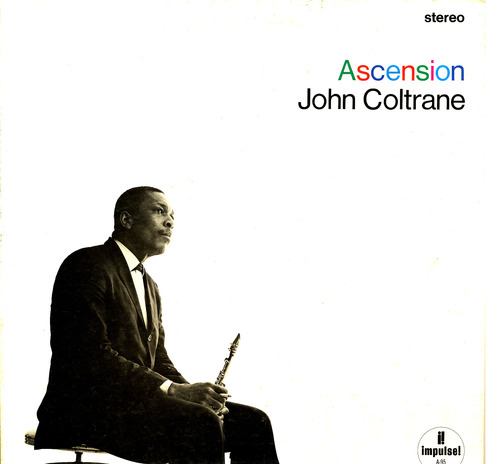 John
Coltrane's Ascension Reborn
John
Coltrane's Ascension Reborn
 John
Coltrane's Ascension Reborn
John
Coltrane's Ascension Reborn
Reviewed by Chris McHale
 There’s
only one way to listen to the original release from 1966 of John Coltrane’s soul
scorching recording,
Ascension, with
pure, utter abandonment. You have to let go and sink into the intense wash of
colors and riffs. It is crazy music. It demands an emotional response. In a
single word, it’s extraordinary. Coltrane called it big band music, but this was
unlike any other big band that ever blew a bent note of soli perfection. This
was an intergalactic big band on wild juice heading full tilt into an out of
control star gone nova. It was the first intensely personal expression of
abstract free jazz ever committed to vinyl, which brings us to the central
question of last Wednesday downstairs at the Jazz Standard in New York City.
There’s
only one way to listen to the original release from 1966 of John Coltrane’s soul
scorching recording,
Ascension, with
pure, utter abandonment. You have to let go and sink into the intense wash of
colors and riffs. It is crazy music. It demands an emotional response. In a
single word, it’s extraordinary. Coltrane called it big band music, but this was
unlike any other big band that ever blew a bent note of soli perfection. This
was an intergalactic big band on wild juice heading full tilt into an out of
control star gone nova. It was the first intensely personal expression of
abstract free jazz ever committed to vinyl, which brings us to the central
question of last Wednesday downstairs at the Jazz Standard in New York City.
Is a Jackson Pollack a Jackson Pollack without Jackson
Pollack? Can a conception and execution, a gigantic improvisation of vibe and
soul, sounding to us from 45 years ago, still play, move and create emotion in a
meaningful way in 2011? And without the archetypal titans of jazz as anchors in
a harmonic universe set free from ancient bounds of expectation, is this music
going to work?
Producer Milan Simich decided
to give it a try. Bringing together an all-star ensemble of power and grace, the
idea was to recreate, to an extent, Coltrane’s iconic release,
Ascension.
The music on that original disc blows your head right through the back wall.
It’s that good. How can you compete with the original congress of jazz gods?
With some doubts, I descend the stairs into the
legendary club, to bear witness to this singular Coltrane homage. How long does
it take me to surrender to this performance? Five seconds.
The audience at the Jazz Standard is eager, the buzzy
club ready for greatness. It’s packed. As soon as you enter the room, the
atmosphere, the appetite is palpable. The set is billed by Simich as Take 1.
It begins with a riff, strong melodic threads connected
in part to Coltrane’s beautiful ‘Love Supreme.’ This opening statement is played
delicately by Joe Lovano on tenor saxophone. The full ensemble joins in,
expanding the theme. It’s an instant celebration of a jazzy right to free
speech. Every musician creates their own space, defined only by a neighborly ear
and a respect for a long gone master’s hand. How can it be that John Coltrane,
with meager strokes and indications on a page ( the existence of a score even at
the original session is in debate) create a durable composition that lives and
breathes 50 years after his passing? I don’t know, but I witnessed it, so I know
it’s real.
The band commits now, weaves
a whole cloth from the late autumn night in NYC. The music evolves, a powerful
jazz soup emerging from chaos. Trumpeter Jeremy Pelt takes a mid-tempo pace,
tone piercing, short bursts of notes followed by a sustained sweep, a statement,
a brassy riff over a steady pulse. The original Coltrane piece called for two
drums, two bass, pushing the boundaries. Tonight we have one bass, the
extraordinary Ben Allison, but he proves up to the task ahead.
After each solo the bands returns, a bendy wash of
perfect horn against a counterpoint of piano, wide voicing, shifting modal
chords skillfully interjected by James Weidman, blocks of colors, a powerful
occupation of the entire keyboard.
Each musician takes a spin
through Coltrane’s creation. Sabir Matin on alto saxophone arrives in thin,
atmospheric high-note splendor. Josh Roseman punches though an incredible
trombone statement over a shifting metric landscape mapped out by Matt Wilson’s
snare and a flurry of tom accents from Billy Drummond.
Donny McCaslin and Vincent Herring each step
into the Ascension circle and create a deep sonic poetry.
The soloing now moves into the rhythm section. Octave
quotes framed by Wiedman’s light touch lead to rising arpeggios, descending
again into an almost Porteresque pass of melodic hints across the full range of
the keyboard. The climax of the work is an astounding one bass between two drums
conversation, a riveting dynamic and pulse, in the middle of which Ben Alison
takes out his i-hone and takes a snapshot! Ascension might have originally been
created in the key of 1966, but it is every bit as relevant today as that
high-tech smart phone.
This review is protected by copyright © All Rights Reserved by Riveting Riffs Magazine